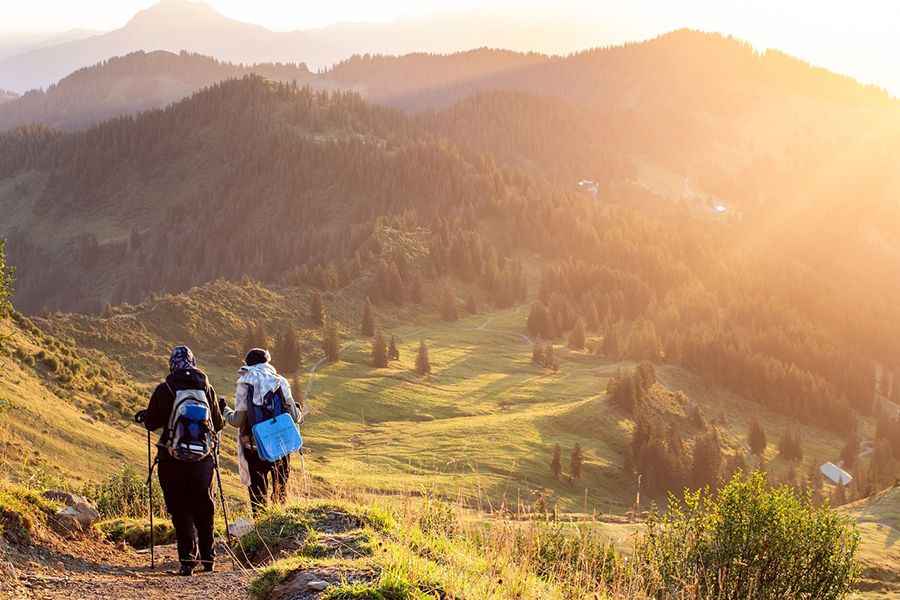The Ultimate Guide to Walking Camino de Santiago
Walking holidays are perhaps the oldest type of holiday known to mankind, historically most commonly undertaken by pilgrims who would go on long journeys for religious motives. Today, however, even with the modern travelling options available, walking holidays are still a popular choice for thousands of people across the globe, coming from a variety of ages, backgrounds and fitness levels. Here’s everything you need to know:

Why go on a walking holiday?
First of all, walking holidays are much easier to plan than you may think. There is a wide range of beautiful Camino de Santiago routes to choose from, so you don’t have to plan your own route. You can also book your walking holiday through area experts, who will plan the whole trip for you, including transfers, reliable accommodation, maps, breakfast and so on. Essentially, it’s a headache-free holiday - you just have to show up ready for adventures.
Besides that, walking holidays are incredibly rewarding and fun, whether you do it with your family, friends or as a solo traveller. It’s all about leaving the stresses of everyday life behind you and getting back in touch with nature. Not only do you walk past breath-taking landscapes and visit historic sites, but some people believe it to be a much deeper journey to inner peace and self- exploration.
Where can I go on a walking holiday?
Camino de Santiago is perhaps the most popular network of routes for walking holidays. The majority of its routes are located in Spain, however, some also include travelling through Portugal or France. Essentially, all of these routes start in different locations and finish at the beautiful town of Santiago de Compostela in Northern Spain, which offers many attractions at the end of the journey, including its infamous Cathedral. Perhaps the most popular choice among walking holiday first-timers is Camino de Santiago from Sarria - a 114km walk in 7 days.
However, there are plenty of Camino Routes across other European countries too, for those who do not wish to travel to Spain for their holiday. The West Highland Way in Scotland, for instance, is a stunning route from Milngavie to Fort William, stretching over 155km in 8 days of walking. A walking holiday in Scotland will be a completely different experience from Spain, with the breath-taking landscape, unique history and culture that the country has to offer.
Therefore, before you choose a particular route, think about which European country you’d like to visit and which culture you are curious to learn about. Whether it’s Spain or Italy, Germany or Romania - each has so much to offer and so it completely depends on your personal preferences.
The types of walking holidays
Just like there are many different locations for walking holidays, there are also different types. These vary based on a number of criteria, including weather conditions, difficulty levels, different terrains and so on.
For instance, if you are a beginner looking for something manageable, there are plenty of introductory to moderate walking routes. These will typically include fairly flat paths and 4-5 hours of walking per day, at your own pace. Introductory routes will not require any previous experience or physical capabilities, so they are also perfect for families. While considered to be quite easy, walking for such long periods of time will undoubtedly bring a feeling of reward at the end.
If you are looking for something more challenging, however, there are many strenuous walking options. These will usually include hilly and mountainous routes, wilderness trekking or climbing holidays. A lot of the time this type of walking holiday will take place in the winter, so the weather conditions are much more challenging too. To go on this type of walk, you will be required to have a lot of previous experience and a serious level of fitness and stamina. It’s typically most popular among gym-goers and adventure fanatics, but with the ranging levels of difficulty, everyone with enough dedication can ease themselves into the more challenging routes.
Lastly, regardless of the difficulty of the route, you may choose whether you want to go on a self-guided walking holiday or with an organised group of people. Many people prefer to go on pre-planned self-guided holidays, as it allows them to go at their own pace, explore the different locations at their own time and take breaks when needed. However, some may prefer going with a guided group of people, this way engaging in different group activities and making new friends with people from across the globe.
How to prepare for a walking holiday?
Depending on the location and the type of route you chose, your preparation in terms of gear and fitness will be different. However, the basic essentials include good walking shoes, appropriate clothing (for the local weather conditions), a comfortable backpack, a water bottle, a map or a GPS system, sun cream for the sunny locations and some healthy snacks to keep your energy levels high.